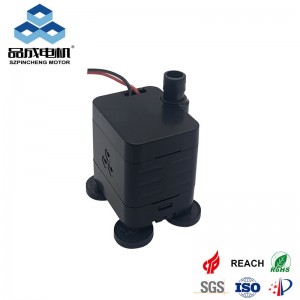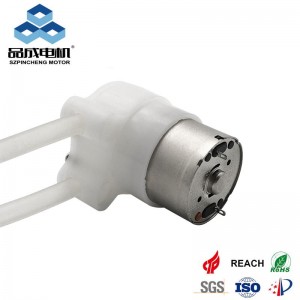Micro submersible pumps are engineering marvels in miniature. Found everywhere from tabletop fountains and fish tanks to intricate lab equipment and compact cooling systems, these silent workhorses move water efficiently while completely submerged. But how exactly do they function? Let's dive into the inner workings of these ubiquitous little pumps.
The Core Principle: Converting Electricity into Water Flow
At its heart, a micro submersible pump operates on the fundamental principle of centrifugal force. Its job is to convert electrical energy from a low-voltage DC (or sometimes AC) power source into kinetic energy that moves water. Here's a step-by-step breakdown:
-
Submersion & Water Entry: The entire pump unit is placed underwater in the fluid it needs to move. Water freely enters the pump through an inlet screen or opening located at its base or sides. This screen acts as a simple filter, preventing large debris from entering and damaging the internal mechanism.
-
The Electric Motor: The core component is a compact, sealed DC electric motor. When powered (typically 3V, 5V, 6V, 12V, or 24V DC), this motor spins at high speeds (often thousands of RPM). Crucially, this motor is hermetically sealed using waterproof gaskets and seals to prevent any water from entering the electrical compartment and causing a short circuit or corrosion.
-
The Impeller: Attached directly to the motor's rotating shaft is the impeller. This is the key component responsible for moving the water. Impellers in micro pumps are usually small plastic or metal discs with curved blades or vanes radiating outwards from the center.
-
Generating Centrifugal Force: As the motor spins the impeller at high speed, the curved blades catch the water that entered through the inlet. The rapidly rotating impeller flings the water outward from the center towards the edge of the impeller housing due to centrifugal force.
-
The Volute Chamber: Surrounding the impeller is a specially designed casing called the volute. This chamber is shaped like a spiral (resembling a snail shell). As the water is thrown outward by the impeller, it enters this expanding spiral volute.
-
Creating Pressure & Flow: The design of the volute chamber is critical:
-
Pressure Conversion: As the water travels through the widening spiral path of the volute, its velocity (speed) decreases. According to Bernoulli's principle, this decrease in velocity results in an increase in pressure.
-
Directional Flow: The volute efficiently collects the water flung by the impeller and channels it towards a single outlet port. This focused channeling converts the chaotic high-velocity water into a more organized, pressurized stream.
-
-
Water Exit: The pressurized water is forced out of the pump through the discharge outlet (usually a small nozzle or barbed fitting). From here, tubing is attached to direct the flow to its destination – be it up to a fountain head, through a filter, over a surface for cooling, or into another reservoir.
-
Continuous Cycle: As water is pushed out the outlet, it creates a slight low-pressure area near the inlet. This pressure difference draws more water in through the inlet screen, creating a continuous flow cycle as long as the motor is running.
Key Components Enabling Submersion:
-
Waterproof Motor Seal: The most critical aspect. Special seals (often mechanical seals or sophisticated O-ring/grease combinations) prevent water from seeping into the motor windings while allowing the shaft to spin freely. This seal's integrity defines the pump's lifespan and reliability.
-
Corrosion-Resistant Materials: Housing, impeller, and seals are typically made from durable plastics (like ABS, PP, Noryl), ceramics, stainless steel, or corrosion-resistant alloys to withstand constant water exposure, especially if used with non-pure water.
-
Inlet Filter/Screen: Protects the impeller from damage by debris.
-
Thermal Protection (Often): Many quality micro pumps have built-in thermal cutoffs. If the motor overheats (e.g., due to running dry, blockage, or voltage issues), this safety feature temporarily cuts power to prevent burnout.
Micro Submersible vs. Other Small Pumps:
-
Submersible vs. Non-Submersible: The key difference is location. Non-submersible pumps sit outside the fluid and must be primed (filled with liquid to start). Submersibles operate directly in the fluid, are inherently primed, run quieter (sound is muffled by water), and often cool themselves via the surrounding liquid.
-
Centrifugal (Submersible) vs. Diaphragm: While submersible diaphragm pumps exist, centrifugal designs (described above) are far more common for micro applications. Centrifugal pumps offer simpler construction, higher flow rates for their size, and generally quieter operation than diaphragm pumps at this scale, but usually generate less pressure.
Types of Impellers in Micro Pumps:
-
Centrifugal Impellers: Standard design with curved vanes, good balance of flow and pressure.
-
Vortex Impellers: Create a vortex (whirlpool) effect. Less efficient but much more resistant to clogging by small solids or hair-like debris. Common in aquarium filters.
-
Paddle Wheel Impellers: Simpler blades, often used where very low head pressure is needed but higher flow is desired.
Common Applications:
-
Aquarium filtration & circulation
-
Small ponds & tabletop fountains
-
Water features & decorative displays
-
DIY projects (cooling systems, irrigation, hydroponics)
-
Humidifiers & vaporizers
-
Beverage dispensers
-
Medical/lab equipment fluid handling
-
Electronics cooling (liquid cooling loops)
Choosing the Right Micro Submersible Pump:
When selecting one, consider:
-
Flow Rate (LPH/GPH): How much water needs moving per hour?
-
Maximum Head Height (meters/feet): How high does the water need to be pumped vertically? (Flow decreases as height increases).
-
Voltage & Power: Match to your power source (battery, USB, wall adapter).
-
Outlet/Inlet Size: Compatible with your tubing?
-
Duty Cycle: Continuous or intermittent use?
-
Fluid Type: Clean water, saltwater, mild chemicals? (Check chemical compatibility).
-
Debris Handling: Does it need a vortex impeller for dirty water?
-
Noise Level: Important for quiet environments.
In Conclusion:
The micro submersible pump is a testament to efficient miniaturization. By harnessing centrifugal force within a sealed, waterproof housing, it reliably moves water in countless compact applications. Understanding its simple yet effective core mechanism – the high-speed motor spinning an impeller within a spiral volute chamber to generate pressurized flow – helps in selecting, using, and troubleshooting these indispensable little powerhouses. Their silent operation, self-priming nature, and compact size ensure they'll remain a vital component wherever small-scale liquid movement is needed.
you like also all
Read More News
Post time: Aug-15-2025




